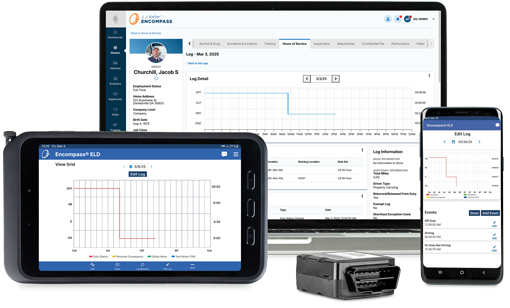Sr. Industry Business Advisor — J. J. Keller & Associates, Inc.
ELD Policies and Procedures
The best ELD policies are ones that are simple, to the point, provide a measurement mechanism, and have “teeth.”
Published On: 11/01/2024
This article was originally published in 2017, and updated in 2024.


Written by:
Tom Bray
There is a lot that needs to be done to get the company transitioned and operating effectively and efficiently on electronic logs, including retraining your drivers and supervisors on the hours-of-service regulations; tightening your electronic log auditing to get drivers into the habit of “running legal”; developing ELD policies and procedures; training drivers and impacted staff on the ELog; and you haven’t even installed the devices yet!
In this article, we’ll concentrate on just one piece of the project — developing the policies and procedures related to the electronic logging system.
Policies and Procedures — Definitions & Development
Once you have selected an electronic logging device, the next step is developing ELD policies and procedures necessary to operate in the electronic logging environment. The best ELD policies are ones that are simple, to the point, provide a measurement mechanism, and have “teeth.” An easy way to develop a policy is to use the ABCDE method. Using this model reminds you to include the following in your policy:
A — The audience to whom the policy applies.
B — The behavior, or action, that you want or require.
C — The conditions under which the policy applies.
D — The discipline that will be taken if the policy is not complied with (the “teeth”).
E — The exceptions that might apply.
When writing a policy, remember that you are not explaining every possible situation. You are simply laying down your expectations, what you will and will not allow, and what will happen if the policy is not followed. The details on how you are going to comply, what you are going to do to make sure everyone is complying, and all the other details related to the policy will be in the procedures that back up the policy. Simply stated, the ELD policy needs to be something that is easily remembered. The procedures are where all of the details reside.
The ELD Policy and Procedures to Start With
If you do not have one already, the place to start is having a clear and concise policy on hours-of-service compliance. This policy lays the foundation for all other policies you develop related to hours-of-service compliance, including your ELD-related policies.
Make sure that this policy does not have any ambiguity or wiggle room. Everyone at the company should have a clear understanding after reading this policy that absolute compliance with the hours-of-service regulations is a condition of employment.
The next step, once any policy is written, is to write the procedures that create the mechanisms necessary to make sure everyone knows the policy and is following it.
Electronic Logging Device Policies
Once the overall hours-of-service policy and procedures are taken care of, you’re ready to write specific policies related to the electronic logging device. There is a lot required, so rather than include it in the general hours-of-service policy, it is better to break the ELD system policies into one or several separate policies. Here are a few topics (Behaviors and Conditions if you think of the ABCDE process) you will need to cover related to the electronic logging policy or policies:
- Logging in using only one’s own credentials.
- Requiring the driver to set the device up for a roadside inspection and present it to the officer.
- Editing only to correct an error or omission, not to create a false record to “get more hours available” or to “try to hide a violation.”
- Dealing with unassigned driving events and edits.
- Dealing with a driver that has deliberately falsified a record or damaged a device.
One of the first policies you should consider writing is what is expected of the drivers — specific do’s and don’ts. For example, “When using an electronic logging device, the driver must/must not”. The policy also provides the exceptions and what will happen if they are not followed (the ABCDE model).
Keep in mind that during the initial rollout, having a “soft” policy (one with a weak disciplinary portion) or not fully enforcing the policy will give everyone a chance to learn to operate effectively in the new environment. Once everyone has adjusted, then you can either update the policy to toughen the disciplinary measures or start fully enforcing the existing policy.
Of course, for each of these policies you will need to have procedures backing them up. Several of the policies will require detailed procedures, such as on how to audit the electronic logs and the unassigned driving events to locate falsifications.
Closing the Loop on ELD Policies and Procedure
The final step with any policy has nothing to do with developing it. Any policy you write must be circulated, trained on, used, enforced, and updated or removed. You’ll need to build in an “automatic review” process which requires an evaluation of each policy and the associated procedures at regular intervals. The policy should be reviewed for accuracy and relevance and appropriate action taken if the policy is not accurate, not current, not being used, or not being followed.
For more information on developing ELD policies and procedures, download our free whitepaper.
Comprehensive DOT Recordkeeping with the Encompass® System
The J. J. Keller® Encompass® Fleet Management System is the industry's most reliable fleet management system. It automates your regulatory recordkeeping tasks, automating workflow processes for highly regulated DOT requirements, like the ELog mandate, driver qualification, hours of service, hiring, alcohol & drug program management & more. Learn more.
You may also enjoy the following articles:
Sign up for our newsletter!
We'll help you stay on top of regulations, best practices, and fleet industry news. Sign up to receive a monthly email notification with links to our most recent blog articles, free resources, and event invites.
